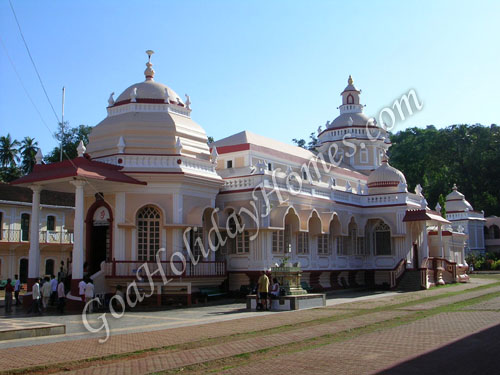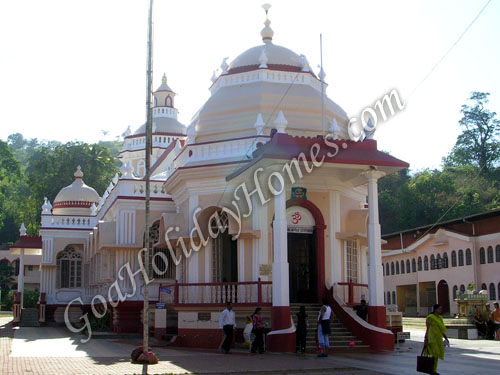Shri Mangueshi Temple

The Mangueshi temple is situated 22 kms. from Panaji (26 kms. from Margao) at Priol in the Ponda Taluka. It is dedicated to Lord Mangueshi, a form of Shiva, which is recognised only in Goa.
Mythology says that Lord Shiva came to Goa after having lost everything in a game of dice against his wife, Parvati. When Parvati came looking for him, he disguised himself as a tiger and frightened her. In a state of shock, Parvati uttered the words, "Trahi Mam Grisha", which when translated means, "O Lord of the Mountains, save me".
Shiva then reverted into his normal form and returned with her. The words, "Mam Grisha" came to be associated with this story and Shiva came to be known as 'Manguesh'. The place where this tale occurred was marked by building a temple at the site. This location is to the south of the Zuari River where the present day village of Cortalim stands. However, when the Portuguese took over, the deity was shifted from its original location to Priol where it remains today.
The Mangueshi temple was one of the temples that was also a part of temple destruction in 1567 by the Portuguese when Salcete was added to their territory. The temple of Mangesh (an incarnation of Lord Shiva) was very ancient and famous and was situated at Kushastali on the south bank of the Zuari river. This village was later known as Cortalim when it came under the Portuguese conquest. It provided one end of the ferry route across the river on the road from the airport or from Margao to Panjim. The temple was supposed to be destroyed and a church to be built on its ruins but the linga was immediately shifted across the river to Priol, where the present temple is located.
There are many legends surrounding the worship of Lord Mangesh at Priol before Cortalim (Kushastali), the most common being the one where Lord Shiva after losing a game of dice with his consort Parvati, lost all his possessions including his heavenly abode atop Mt. Kailasa and wandered away before resting at Kushastali for meditation which incidentally was a part of South Goa. Parvati went in search of Shiva and was confronted by a fierce tiger. She cried to Lord Shiva for help only to find the tiger none other than the Lord himself who had taken the form of a tiger to test her courage.
The reunion of the two was indeed joyful and to celebrate this, Lord Shiva adopted the last 2 words, "Mam Girisha" of the cry for help from Parvati as one of his abundant names. Lord Shiva left a linga before departing for his abode, and this was discovered by a cowherd whose cow used to sprinkle milk on the same spot regularly and that was how the temple of Mangesh at Kushastali came into existence. The name Mam Girish was abbreviated to Mangesh and so it has remained till today.
Earlier, the shrine of Mangesh at Priol was simple and nestled amongst the palm groves of the valley since the linga was in Priol for more than four centuries. It was only until the middle of the 18th century, Ramchandra Sukhtankar, a respected general in the Maratha court revived the linga from its place and convinced the Raja of Sonda, to donate land for constructing the temple and providing funds for its maintenance. The new temple is well maintained till today with the daily rituals carried out by the management of priests, musicians, dancers and other artists besides the farm workers.
The Mangueshi temple is managed by a managing committee elected by the trustees or Mahajans of the temple. The estate of Priol, even under Portuguese control, could not deter the temple of Mangesh to be reconstructed many times since the 18th century as per the endowment of the temple by the Raja of Sonda who surrendered Ponda to the Portuguese. The way to the temple is marked through an arch along a pathway paved with laterite slabs although it can be by passed along an alternative motor road. The most unique features of the temple include the lamp tower or the gleaming white Deepstambha, the water tank believed to be one of the oldest, twin ramps leading to an arch in a central gate tower in the front wall, the naubat khana, where music and drums are played. The water from the ancient tank reflects the ancient walls of the temple as well as the gateways of the temple including the tip of the lamp tower. The temple although not the largest amongst the temples in Goa, is intricately designed and proportioned. The courtyard has numerous agarshalas or buildings with rooms for pilgrims, marriage or thread ceremonies, together with the administrative offices, with a well in the far corner.
The high storeyed Deepstambha is classical and elegant in its own style and on its bottom storey are panels carved with religious themes and figures of deities. There are various domes over the entrance hall with a repeat of the octagonal type of dome and the two side entrances creating the cruciform ground plan are also domed. The entrance hall is linked with the tower over the sanctum by a steep tiled roof over the mandapa. An octagonal drum supports the dome of the tower which is extended for height purposes. The dome in turn supports a cylindrical lantern with a gleaming golden finial elegantly built and linked by balustrades appearing at each level. The design of a flattened globe or 'amalaka' symbolizing fruit and fertility is vertically grooved all round except the main dome.
Besides the main temple of Mangesh, there are other shrines dedicated to the family deity within the temple itself or separate temples within the temple complex. Outside the main temple in the courtyard, is a temple dedicated to Lord Bhairava, a violent form of Lord Shiva. This image is magnificent made of black basalt. Besides this, are shown Shiva's four traditional necessities namely his trident, sword, kettle drum and cup not to forget Brahma's severed head in his left hand which he cut off during one of his altercations with the Creator leaving him with only four heads. Behind the main temple, is a temple dedicated to Mukto or Mulkeshwar who was responsible for carrying the image of the Lord to Priol in the 16th century during temple destructions. He is also associated with Multo, the God of the Kundbis.
A temple to Shanteri, the village Goddess of Peace is also found besides the ancient water tank outside the courtyard. Besides this, there are temples dedicated to Lord Ganesh and Devi Bhagwati, the most important members of the family deity. Near the lamp tower is the tulsi vrindavan colourfully decorated with tiles.
The symbol of the Supreme Being, "OM" used in meditation is found above the main entrance atop the steps. The mandapa is divided by 2 rows of four huge round columns beyond the octagonal entrance hall. The ceiling is decorated in definite geometrical pattern clustered with impressive chandeliers and lamps of varied designs. The temple bells hanging between make it worthwhile for another look.
The image of the Nandi bull also known as Shiva's mountat the far end of the hall lies just before the screen that secludes the main shrine and a carved wooden rail ensures further protection on either sides. The screen is deeply carved and overlaid with silver similar to reredos in churches. The beautiful designs are inspired from many sources with the two massive doors leading to the shrine housing the deity deep within. Either side of the doorway has silver statues of guardians of the shrine encased in niches of the screen.
Two temples dedicated to Lord Ganesh or Ganapathi and Goddess Parvati or Bhagavati are found either side of the main temple screen. Lord Ganesh is an important deity of the Hindus and is revered all over, justifying his presence on lamp towers, doorways and tulsi vrindavans. The elephant headed God, is widely revered as the Remover of Obstacles and the deity of Wisdom and Prudence and is always worshipped before the start of any religious function or embarking on any journey. Depicted as the Elephant headed God who loves sweet things, he has a fat belly and has a rat for his mount.
The palki or palanquin is kept in one of the aisles and taken out in processions on festival days. The linga, on certain occasions, is decorated with a mask and dressed in rich robes and jewels. The Mangesh Temple is one of the important temples in Goan history and is well worth its description, but the Mahalsa temple at Mardol, 1 km along the road from Priol, is well worth the visit.
Contact Details
Get Directions:






